📝 Interviewing Objects: Giving Life to Everyday Things 🌟
In the Language chapter "Self-Expression and Communication Through Written Language", we discover a series of engaging presentations as part of "Poetry’s Toolbox". One such exploration is interviewing an object and transforming its answers into a poem. ✨ By personifying objects 🪑, pencils ✏️, or even a cheerful mug ☕, children unlock the hidden stories and personalities of the everyday things around them. Through playful questions like “What’s your favorite thing to do?” or “What would you say if you could talk?” 🎙️, they develop imaginative thinking while building essential language skills. This creative exercise nurtures poetic exploration, inviting children to experiment with rhythm, vivid imagery 🎨, and humor 😂, all while giving objects their own unique “voice.” 🌟✨
LANGUAGE STORIES
11/19/20242 min read


Let’s imagine objects can talk! 🗣️ Today, I interviewed a mug ☕, asking it questions about its life, its memories, and even its dreams. Then, I turned its answers into a poem.
You can pick any object—a rock 🪨, a chair 🪑, or even your favorite pencil ✏️! Ask it questions like:
How old are you? 🕰️
Who are you ? 👓
What do you love about your job? 🎉
What’s your favorite thing to do ? 📜
What you do not like?
What would you say if you could talk ?🌟
Write down the answers, and use them to create your own poem. When you listen to an object’s 'voice,' you might discover a new way to see the world. 🌍✨
🗨️ My Interview with the Dotted Mug ☕
Interviewer: Hi there! You’re such a colorful mug. Can you tell us about your spots?
Mug: Oh, my spots? Aren’t they fabulous? 🎉 They’re like little party confetti, reminding everyone that even mornings can be fun!
nterviewer: What’s the best drink you’ve ever held?
Mug: Oooh, hot chocolate with marshmallows! 🍫☁️ The marshmallows melted into gooey clouds, and I felt like I was holding happiness itself.
Interviewer: What’s the funniest thing that’s ever happened to you?
Mug: One time, I tipped over because someone accidentally bumped the table. I made such a loud clatter! Luckily, I didn’t break, but I scared a cat nearby—its tail puffed up like a feather duster! 😂🐱
Interviewer: If you could talk to your spoon, what would you say?
Mug: I’d say, “Thanks for always stirring things up! But could you stop tickling me with your handle?” 🥄
Interviewer: Is there something you do not like?
Mug: Being left in the sink for too long. 😟 I mean, I love a good bath, but not when I have to wait with leftover coffee stains!
Interviewer: Well, thank you so much for chatting with me today! Is there anything else you’d like to say before we finish?
Mug: Just this—don’t forget to fill me with something warm and cozy tomorrow morning! ☀️ And maybe give me a little rinse after—you know how I feel about being left in the sink!
Interviewer: Will do, Mug! Thanks for being such a colorful part of the day.
Mug: Anytime! Now, go enjoy your day, and remember—life’s better with a splash of fun, just like my spots!
Here's my poem crafted from the interview :
My Happy Mug ☕✨
I’m a mug with cheerful spots,
Bringing joy in sips and lots.
Hot chocolate’s my favorite thing,
With marshmallows floating, I want to sing!🎶
I don’t like the sink, left cold and stained,
But with warmth and care, I’m never pained.
Fill me tomorrow, and you’ll see,
How happy a mug like me can be😊
🌈 What Did You Notice?I used the mug’s answers to create the poem. It’s like I gave the mug a chance to share its personality with us! I also ended each sentence with a rhyming word. Doesn’t the rhyme make it sound fun and easy to memorise? 🎵
Now, it is your turn. Think about an object you use every day—a book 📚, your water bottle 🚰, or even your shoes 👟.What would it say if it could talk? And then turn its answers into a short poem like this one! Poetry lets us bring objects to life and use our imagination to explore the world in a new way. What will your object say? 🌟😊
With Montessori joy,
Vanina 😊

